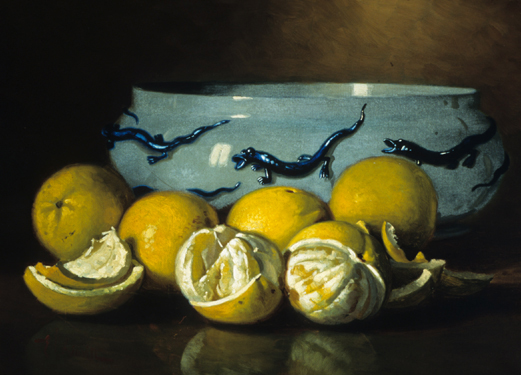
Edward E. Leavitt
American, 1842-1904
Grapefruit, 1880-1890 ca.
oil on canvas
16 x 22 in.
Gift of Charles C. and Elma Ralphs Shoemaker
1994.34.9
RESEARCH PAPER
Born in Providence, Rhode Island, on March 9, 1842, Edward Chalmers Leavitt was a direct descendant, on his maternal side, of Priscilla Mullens and John Alden, who arrived in Plymouth on the Mayflower. On the paternal side he descended from John Leavitt, who was an immigrant on the first ship to arrive in Massachusetts Bay. At the age of 20, he served in the Navy during the Civil War. After leaving the service, Leavitt devoted the remaining years of his life to painting, dying at the age of 62 in Providence on November 20, 1904.
Apart from some instruction in painting from James M. Lewin, Leavitt was essentially self-taught. Although Lewin attempted to influence him to paint along idealistic and poetic lines, Leavitt was self-confident and developed his own distinctive style, which was material and realistic. His specialty became still life oil painting, featuring fruit and flowers, often incorporating valuable ceramics and bronzes in luxurious settings. He maintained this style throughout his artistic career, and it proved to be the key to his success.
In the late nineteen hundreds it was the custom for people to decorate their homes with large numbers of easily understood paintings. Many homes had row upon row of paintings and the demand seemed to be almost inexhaustible. The populace, at that time, preferred nature as the
subject for its artworks, and consequently Leavitt's beautifully composed and sharply detailed paintings became popular and much sought-after. Research has indicated that Leavitt probably completed more than a thousand works, which were sold primarily in New England.
Exhibitions of his work were held at the National Academy of Design in New York City from 1877-1886. He also had well-received exhibits in Providence and Boston.
Grapefruit was almost certainly executed at the height of Leavitt's artistic career, from 1880-1890, as the quality of his work showed a rapid decline after 1892. Grapefruit appears to be set indoors, featuring grapefruit and a bowl that is hand-crafted. The objects are arranged on a hard shiny surface, probably a highly polished table.
Painting realistic fruits or flowers in an opulent setting became a distinguishing hallmark of
Leavitt's still life paintings. He often featured ornate silver pieces and priceless antiques on magnificent wooden furniture, demonstrating the temporality of all earthly pleasures.
In this still life, soft curved edges define the realistic round shapes of six grapefruit and the graceful lines of the footed bowl. The lizard-like creatures on the bowl are depicted in high relief, with fluid curvilinear lines creating a sense of movement and action. An exotic oriental feeling is created by the color and the design of the bowl, adding sophistication to the work.
The subject matter was obviously arranged, not natural. The precise peelings of the grapefruit, as well as the sections of fruit, create diagonal lines that direct the eye to the apex of the painting – the bowl. The composition is asymmetrical but balanced. Horizontally the painting is divided into thirds with the grapefruit being right up front. The bowl occupies the middle third of the painting with the soft, chocolate-brown and golden backdrop, adding drama to the top third of the composition.
The rich yellows of the grapefruit contrast with the blues in the bowl and the browns of the background and table. White was used deftly by the artist to emphasize the sharp outlines and internal coloration of the sectioned fruit. Leavitt skillfully blended the colors in the grapefruit, making them look very realistic; their skins have a natural roughly textured appearance. This painting appeals to the senses because of the lushness of the rare and desirable grapefruit.
The grapefruit and bowl appear to be in a strong shaft of sunlight, which reflects from the skin of the fruit, and even more so from the surface of the bowl. In the upper right corner of the painting, a lighter area gives a feeling of depth. The varied brush strokes – some sweeping, some detailed – heighten the sense of realism and volume.
This oil painting is extremely effective in attracting the attention of the viewer because of the artist's crisp touch with reality and incredible attention to detail. The proficient interrelations of the rich colors and light in this still life splendidly reaffirm the feeling that this work was executed by a master of his craft. Justifiably, Leavitt's works have been compared with those of European masters.
Prepared for the SBMA Docent Council by Peggy Hughes Howarth, 1996.
Typed and edited for the SBMA Docent Council website by Stephanie Amon and Lori Mohr, fall 2012.
Bibliography
Arnold, John Nelson. Art and Artists in Rhode Island. 1905.
Falk, Peter Hastings, ed. Who Was Who in American Art. Madison: Sound View Press, 1985.
Gerdt, Wm. H. Art Across America, vol. I. New York: Abbeville Press, 1990.
Gombrich, E. H. The Story of Art, 4th Ed. Rev. Phaidon Press Ltd, 1951.
Herndon, Richard. Men of Progress. 1896.
Janson, H. W. History of Art, 5th Ed. New York: Harry N. Abraus Inc., 1995.
Miner, George Leland. Angell's Lane. 1948.
Richardson, E. P. A Short History of Painting in America. New York: Thomas Y. Crowell Co., 1834.
Slocum, Grace L. Who's Who in R.I. 1945.
Taylor, Joshua C. America as Art. New York: Harper & Row Publishers, 1976.
Wiedmerding, John. The Pelican History of American Art. Harmondsworth, Middlesex, England: Penguin Books, 1976.
